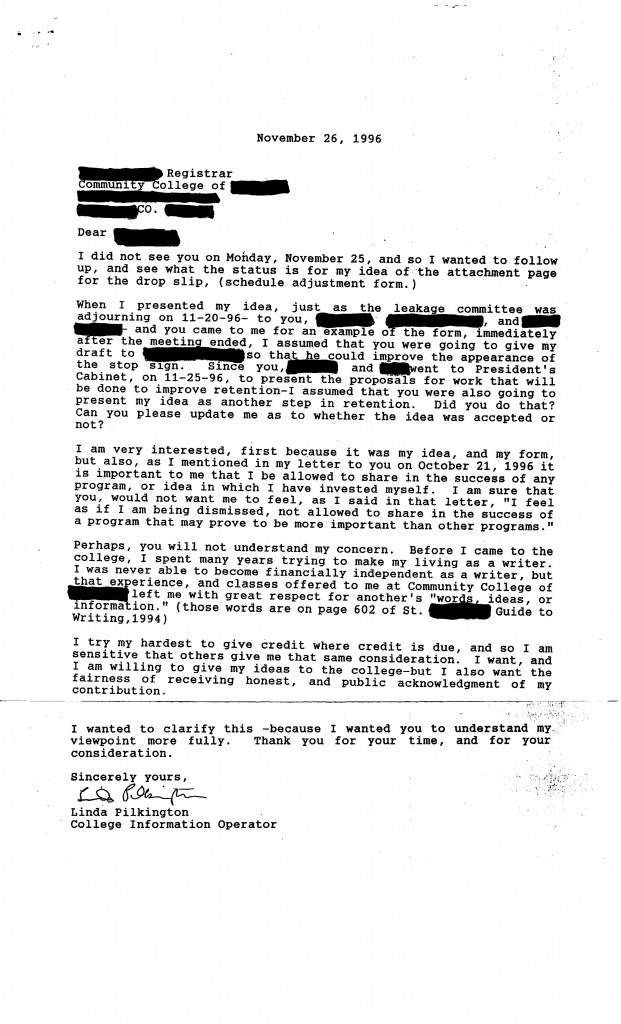Plagiarism Part 6: Larceny and Lies
This is the sixth post in a series about creative plagiarism. Read more here:
On November 20th, 1996, I had presented my design for the Stop Form to a committee that included my former boss, who was now dean over my college’s registration department. Until she had seen my presentation, her team had come up with zero solutions for the student retention problem. Dean Joey was instantly enthusiastic about my idea because it gave her something of substance to take to the upcoming President’s Cabinet meeting. Mine was a simple and creative solution that had appeared just in the nick of time; the Stop Form would save her rear.
After the meeting with Joey, I felt hopeful but realistic. I knew that Dean Joey had a limited supply of generous impulses. She was interested in her life, her career, and her prosperous future; she was not at all concerned with mine. Her assistant Stella was also a problem. Since I’d gone over her head to get a raise, Stella had become my implacable office enemy who wouldn’t stop trying to make me miserable until I quit the registration department. And as much as Stella could influence them, Dean Joey and my boss Ryan would never be fair managers for me. Even without Stella’s bad influence, Ryan was not of good character. He craved power, and to his mind I stood in the way of his gaining that power; he wasn’t about to declare himself my friend on some sunshiny morning.
But, surely, I reasoned, The Stop Form had improved my position. The Stop Form had arrived at the right moment; it was exactly what the college needed. This could be my career breakthrough –now my managers would have to work with me instead of against me. And The Stop Form might force them to give me the respect they gave to other employees in my department and allow me to work in peace for the first time in years.
I comforted myself with the thought that this time, my idea couldn’t be stolen by higher-ups. Too many people had seen it and knew that the Stop Form was mine and mine alone. This time what I had created — my work, my intellectual property — would finally, improve my job standing and my own life, instead of the life of some manager who had plagiarized my work.
After seeing the Stop Form for the first time on November 2oth, Ryan and Dean Joey presented it at the President’s Cabinet meeting on November 25th as our community college’s new method to improve student retention.
For a few brief, glorious days, I’d been hopeful. But Ryan didn’t call me or stop by after the meeting to bring me up to date on what had happened at the President’s Cabinet. I’d known for a long time that Ryan and Dean Joey’s ethics were not to be depended on; too soon that familiar knot in my stomach returned. I was left with my usual question: what was going on?
Before I presented the Stop Form, I’d promised myself that I would not lose any more of my ideas or designs to the college, that from now on, I was going to ask questions about how the college was using my work in order to protect my work. I was going to follow up.
When I didn’t hear from Ryan I kept that promise. The letter I wrote Ryan the day after the cabinet meeting, asked what was happening with the Stop Form. In that letter I made a statement about an authors’ ideas belonging to the authors themselves.
A day or so after receiving my letter, Ryan finally stopped by the switchboard room on his way out of the office. His usual style in dealing with me was to make an entrance by bursting through the door, making his demands, quickly hurling an insult, and then making a fast exit.
This time Ryan didn’t seem quite so confident. He didn’t meet my eyes with the usual hostile stare. He was ill at ease.
Of course, I hadn’t expected him to thank me or waste his breath with any compliments about the Stop Form. My experience with him, the Dean, and Stella had taught me to expect neither praise nor thanks for my work. They saved their praise and thanks for the higher-ups, for the friends that they employed, or for a few chosen office favorites. Their unanimous choice as the office favorite was Anise, a young Latino woman who, with the help of affirmative action, and a job slot that was reserved for minorities, had become a classified employee before I did. They had left me, a woman in her fifties, to work for low wages for years, and to fight each step of my way to classified status.
Finally after a few questions about the level of calls to the college, and my answers, to which Ryan barely listened, he was ready to broach the subject he’d been avoiding.
“The college may be interested in using The Stop Form,” he said, almost choking on the words, and then without any details about the cabinet meeting he hurried on.
“As a classified employee you should be honored if they make that choice,” he said pompously.
His implication was that if something so unlikely happened and the college stooped to use my unworthy creation, that I should realize that the college had done me a favor. I was to be quietly grateful for that notice and for his, and their, condescension.
I flushed and looked away; evidently Ryan hated the thought of too much honor being bestowed on his unworthy underling. What a nasty manner he had! But it wouldn’t do any good to follow my impulse and answer back; my only satisfaction was seeing him carefully controlling his own envy, anger, or whatever feelings were causing his eyes to burn and his face to flush.
Instead, I asked him how the college would reward me for the use of the form. Would I get a raise? Would I get a change in job classification? Would the college administration announce that it was using my design in the Daily Highlights, the news letter that came from the college president’s office?
He scowled. Obviously, I had irritated him. How dare I feel that I had the right to ask any questions whatsoever? For a moment he seemed on the brink of shouting “Upstart!” and stalking out. He heaved a sigh and restrained himself.
“It’s too soon to talk about any of that…” he said, to which I silently responded, “But it wouldn’t be too soon to talk about all of the details of your profiting from it if this was your Stop Form, and to your advantage, would it, Mr. Surly?”
As he spoke I was trying to figure him out. He was hostile, but he was also nervous. What was going on in his mind; what was he not telling me?
But he had had enough of me and enough of my questions. He said that he would get back to me, and with a final scowl, he swept out of the office.
I pondered the news I’d gotten and Ryan’s behavior for the next several hours. And I spent time getting past some of my own thoughts.
“If it had been Anise who had designed the Stop Form, Ryan, Stella, and Joey would have gushed and then paved her way to success. They would have bragged about her creativity to the rest of the staff, and throughout the college. They would have rushed the college into manufacturing Stop Forms to sell to other colleges nationwide. They would have made her way forward easy.”
But I soon stepped beyond my feelings. I couldn’t do anything about their dislike of me. The office environment was unfair, and the office politics meant that they weren’t going to help me–not ever.
My business was to figure out what was really going on, and if I had to, to protect my property. Intuition told me that when managers and Deans were evasive that I should watch my back; experience had shown me that these people were capable of both lies and larceny.
Nobody else in the college was going to protect me and so I had to protect myself. There was only one way that I knew how to do this. I had to register the copyright for The Stop Form.

